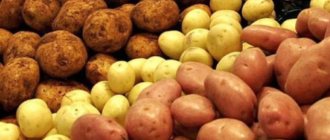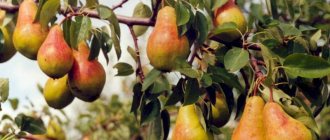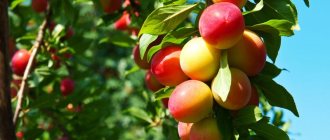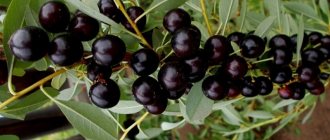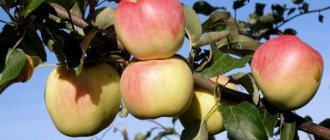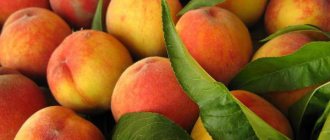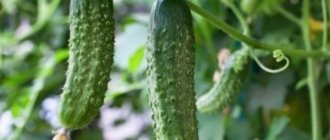What potato varieties are suitable for the Urals
By choosing suitable varieties for the Urals or Siberia, you can get a good harvest every year. In summer, the Urals experience warm, rainy weather with temperatures reaching +35 degrees. At the same time, there is an invasion of Arctic air masses with strong winds, which lead to frosts. Sometimes it can even snow in June.
However, it is not necessary to choose exclusively early potato varieties. You can also choose mid-early, mid-season and even mid-late, only zoned for the Urals. It is also worth paying attention to the culinary type of variety.
Next, the best varieties for cultivation in the Urals will be described in more detail.
Subtleties of cultivation
Potatoes are an unpretentious but heat-loving crop. Therefore, options for winter planting on the Ural lands are excluded. The soil freezes deeply and for several months in a row, so the tubers have no chance of survival. Early planting is also pointless, because the tubers begin to grow only at a temperature of +10 C.
Agricultural experts recommend planning to plant potatoes in the Urals in the second decade of June. In this case, the first shoots will appear early, after 8-10 days, and harvesting will take place in August. If you plant potatoes in open ground too early, there is a high risk that they will sprout just during the period of late frosts. Planting in well-warmed soil ensures rapid growth of the crop and minimizes the risk of fungal diseases.
Related article:
5 best potato varieties for planting in June that are guaranteed to yield a good harvest
With the Ural method of cultivation, the main pests of the crop, the Colorado potato beetles, do not have time to lay larvae. Therefore, treating plantings with toxic substances is unnecessary and useless.
Agrotechnicians recommend regularly updating planting material. It is best to purchase elite potato seeds of proven varieties and new breeding discoveries.
The most delicious
Rosara
An early ripening variety characterized by excellent taste of the fruit. Moderately resistant to scab and late blight.
How to combat late blight on potatoes: effective chemical and folk remedies, late blight-resistant varieties
Vegetables do not become overcooked or darken during cooking. Ideal for frying, French fries and chips.
Characteristics:
- The ripening period is early (52-65 days);
- Shape: oval;
- The peel is pink;
- The pulp is yellow;
- Starch content - 12-16%;
- Productivity per hundred square meters - 350-400 kg;
- The average tuber weight is approximately 80-115 g;
- There are 12-16 pieces on 1 bush;
- Well kept.
Picasso
A variety of late ripening period, which is characterized by excellent taste of the fruit. Not afraid of drought and high temperatures. Susceptible to viruses, resistant to diseases.
Vegetables do not become overcooked or darken during cooking. Ideal for salads and frying.
Characteristics:
- The ripening period is late (111-130 days);
- Shape: oval;
- The peel is yellow;
- The pulp is yellow;
- Starch content - 10-12%;
- Productivity per hundred square meters - 200-500 kg;
- The average weight of a tuber is approximately 80-140 g;
- There are 8-12 pieces on 1 bush;
- Well kept.
Top 10 best varieties
We present the 10 most popular potato varieties for growing in the Ural region. The proposed options have already been tested by vegetable growers and are considered the best for harsh climates. All varieties are early ripening, late blight resistant and productive.
Vineta
Extra early table variety - ripening period 65 days. Plants are resistant to drought and low temperatures. One bush produces an average of 10-12 tubers, weighing 70-100 g. The pulp is light yellow, tasty and crumbly when cooked, the color of the peel is dirty yellow. The bushes are powerful, reaching a height of 50-70 cm, with a large number of large light green leaves. It blooms with large white flowers with a yellow center. Mature tubers tolerate transportation and long-term storage well.
Related article:
When and how to properly hill potatoes
Governor
Ultra-early subspecies with a growing season of 60 days. The bushes are compact, up to 50 cm high. Governor is characterized by increased resistance to late blight and cancer virus. The yield is high - 10-12 large tubers per bush (1.8-2 kg). The peel is dirty red, the eyes are shallow, the flesh is white. Thanks to its plasticity, high yields are maintained even in unfavorable years.
Suitable for cultivation in personal plots and for commercial cultivation. The peel is resistant to damage. The keeping quality indicator is high. Governor is good for making French fries and frying. The disadvantage is that it is not suitable for making purees.
Rosara
Rosara's red potatoes, according to reviews from vegetable growers and tasters, are considered the most delicious. The bush has a semi-spreading shape, more than 50 cm high, thick stems and red-violet flower corollas. Smooth, oblong tubers are distinguished by yellow, dense pulp. Due to the low starch content, vegetables do not fall apart during cooking. Crumbly and slightly sweet, Rosara is suitable for baking and pureeing.
Related article:
How to plant potatoes
In addition to its excellent taste, the variety has many more advantages - high yield (up to 30 pieces per bush weighing 100-150 g), short growing season (45 days), resistance to major crop diseases. The downside of the variety is that the tubers are not suitable for long-term storage.
Rodrigo
Rodrigo's growing season is 75-85 days, so this option is only suitable for the Southern Urals. The mid-early variety is famous for its large mass of tubers (500-800 g) and excellent taste. The starch content is average, so vegetables are more suitable for heat treatment as a whole, for salads, frying, and soups.
Bushes of 3-5 stems reach a height of 75-80 cm. The color of the peel is pink, the flesh is yellow, the eyes are shallow. You can dig up the first crop within 60 days of planting. But only mature tubers with strong skins are suitable for long-term storage. Rodrigo is characterized by increased resistance to viral diseases.
Related article:
Reasons for low potato yield
Alyona
An early ripening variety with a growing season of 60-70 days. Plants are compact, not spreading. The leaves are small with wavy edges. The flowers are white. The yield is high - 15-20 tubers per bush (average weight 90-150 g). The color of the skin is reddish, creamy when cut. The taste is good. Potatoes are suitable for cooking in any form.
The correct round shape of vegetables is an ideal product for making semi-finished products. Therefore, Alena is the most popular variety among farmers. Also valued for its excellent preservation (95%), unpretentiousness to soil fertility, resistance to drought and strong immunity.
Bashkir
Developed specifically for the Ural climate. Resistant to nature's surprises and easy to care for, Bashkir brings a good harvest. The yield from one bush is 8-10 vegetables, with an average weight of 150-200 g. Purpose - universal, high consumer qualities. Keeping quality is good (95%). Potatoes are oval-round in shape. The skin is red, the flesh is creamy. Eyes of medium depth.
Related article:
How to preserve the harvest until spring: 6 mistakes when storing potatoes
The plants are of medium height, the stems (from 4 to 8 pieces) are semi-erect. The leaves of Bashkir have an incredible ability to shed clutches of Colorado potato beetle larvae. For this feature, the variety is loved by all summer residents of the country.
Red Lady
The variety is a real find for Ural vegetable growers. Early ripening is combined with excellent keeping quality. In addition, compact plants are completely unpretentious to soil fertility and care. Drought-resistant bushes with strong immunity bear a rich harvest even in unfavorable years (12-15 vegetables, 100-150 g each).
The potatoes are colored red-pink, pale yellow when cut, oval in shape and the same size, the yield of small non-marketable potatoes is insignificant. The taste is excellent.
Zhukovsky early
Excellent taste, early ripening (60-70 days), high yield (50 kg per 1 sq.m.), resistance to adverse conditions - all these are the advantages of early Zhukovsky. The peel of the vegetables is red, the flesh is snow-white with an average starch content. The consumer qualities are high (suitable for cooking, making chips, fries).
Related article:
How to fertilize potatoes
The thin but durable peel of Zhukovsky allows the use of mechanized harvesting methods and storage of vegetables for a long time. Among the disadvantages of the variety, there is a high susceptibility to late blight.
Spiridon
Mid-season table variety for the Southern Urals. Tubers are ready for harvest 90-100 days after planting. Vegetables are of excellent commercial quality - regular oval shape, red color, white flesh, does not darken when peeled, does not fall apart when cooked. One of the disadvantages is that potatoes are afraid of transportation.
Dry vegetables without mechanical damage are stored well for several months. The tops are compact in size. From 1 sq.m. yield is about 50 kg. According to the All-Russian Research Institute of Phytopathology, it is susceptible in the tops and moderately resistant in the tubers to the causative agent of late blight.
Related article:
Excellent potato harvest using Balabanov’s method
Nevsky
A mid-late variety with high yield and high consumer qualities. Vegetables contain a minimal amount of starch, so they are perfect for dietary nutrition. Tubers reach technical maturity 85-90 days from planting. Plants are resistant to cancer, rhizoctonia, alternaria and blackleg.
Excellent genetically inherent plasticity allows you to obtain rich harvests in any weather conditions. The tops, like the root system of Nevsky, are powerful. When planting, you need to take this into account and leave a distance between rows of 60-70 cm. From one nest you can collect 2-3 kg of marketable vegetables. The potato is shaped like an oval, the skin is light yellow, smooth, and the flesh is creamy.
Features of growing Coletta potatoes
The timing of planting Colette potatoes varies significantly across regions.
When to plant? The timing of planting Colette tubers in the regions of our country varies significantly. In the southern regions this is the end of April - the beginning of May, in the central and northern regions - the middle and end of May. The indicator for starting agricultural work is sufficient soil moisture, its warming up and the absence of frost on the ground and in the air. After all, early and late planting of potatoes often leads to a decrease in yield.
How to plant?
You can increase the yield if you warm the tubers until small sprouts form on them. It is better to plant seed material in rows. The row spacing is at least 75 cm, and the distance between plants in a row is 30 cm.
Before planting, planting potatoes are treated to stimulate growth and protect against diseases with the following preparations: Prestige, Cruiser, Albit, Force.
Potatoes planted in the ground require proper care to obtain a good harvest.
How to care?
In the process of growing Colette, a number of mandatory measures should be performed:
Hilling is carried out in several stages throughout the growth of the stems. The first time you should “burn” the row on both sides after the first 2-4 leaves appear above the surface of the ground (you can cover the seedlings completely with soil). This will protect tender shoots from low temperatures at night. The next 1-2 hillings are carried out until the potatoes begin to flower;
Loosening the soil and removing weeds. Carry out as harmful plants appear. The first loosening can be carried out even before germination. In this case, the tool should not be deepened more than 1-1.5 cm, so as not to damage the sprouts. It is convenient to combine subsequent procedures with hilling;
Watering is carried out if there is no rain
It is very important that the soil is moist, but it should not be over-moistened.
Feeding. Carry out 2-3 times before flowering with Nitrophozka, Sortvorin or Effekton
The first fertilizing should be applied if the tops are thin and the leaves are light in color. The second and third times you should “feed” the bushes with an interval of 10 days.
It is imperative to spray potatoes against pests - the Colorado potato beetle. This will make it possible to preserve the harvest without loss.
How to get 2 harvests in 1 season?
Colette is an early ripening variety that allows you to grow 2 crops from spring to autumn without any problems. With proper care, the first harvest is obtained in mid-July. Drying tops serve as a signal for the start of harvesting. You can dig up bushes either manually or using machinery, which significantly speeds up the harvesting process. After harvesting the potatoes, the soil is weeded to remove weeds and dry tops, cultivated and moistened. After this, you can start planting potatoes. Planting and care activities are similar to those carried out when receiving the first harvest.
Colette potatoes have very good immunity to potato canker pathogens
The Colette variety is an option for getting a large harvest in one season. At the same time, it is well stored until spring, resistant to late blight and diseases, and is not damaged during transportation. Colette potatoes are the best option for both individual cultivation and farms.
This is interesting: Strong Potatoes - what you need to know
Growing potatoes in the middle zone
A characteristic feature of the Middle Zone, in other words, the Central European part of Russia, is a moderate continental climate and excess humidity. There are no severe frosts or heat here. Moderate seasonality: snowy and mild winters and warm and cool summers. Average temperatures in winter range from -8, -12 degrees, in summer +17, +23. The warm period lasts from the end of May to mid-September.
Gardeners in this region have to devote all their efforts to combating excessive moisture, which turns their peaty and podzolic soils into swamps. The potato yield here is quite high - up to 0.5 tons. With special care, these figures increase by 10–20%.
Types of Potatoes
According to the speed of ripening, potatoes are divided into the following types:
- Early ones - ripen 50-60 days after germination, cannot be stored, and are eaten immediately after digging.
- Mid-season - 70-90 days from germination - are distinguished by good growth and storage in the conditions of central Russia.
- Late ones - more than 100 days - are not grown in the open ground of this region, as they do not have time to ripen.
Planting potatoes in the central zone begins in early May, when the soil warms up to +12 degrees, and the night air is not lower than +15 degrees. At first, planting is covered with film to prevent sudden frosts.
Potatoes are usually watered with precipitation. The exception is the appearance of sprouts, budding and the end of flowering. During these periods, plants need additional watering and fertilizing.
Not every potato variety can be grown in central Russia
Variety depending on climate
A good harvest will be produced by a variety that matches the soil type and climatic characteristics of the region. The middle zone is a huge territory, in different areas of which there are distinctive weather conditions. Therefore, preferences are given to different varieties of potatoes.
For example, in the Moscow region, with its high humidity and cloudiness, mainly early potato varieties with good resistance to late blight are chosen for planting. The most common are Early rose, Falensky, Provento, Lyubimets, Ostara, Lorch, Peredovik, Priekulsky early, Penza early ripening, Lugovskoy, Nevsky, Charodey, Sineglazka, Udacha, Zhukovsky.
In the north-west of Russia, varieties that tolerate frost and sudden temperature changes have an advantage. Popular are Amorosa, Impala, Latona, Karatop, Nida, Garnet, Romano, Aurora, Folva.
Features of caring for the variety after planting
The agricultural technology for growing Merlot is the same as for other potato varieties. The crop needs to be regularly looked after - watered, fed, weeded, hilled and prevented from pests and diseases.
Fertilizer and watering
According to agrotechnical standards, the Merlot variety is fed three times during the growing season:
Find out what and how to properly process potatoes
- during the period of active growth of bushes - a solution of 0.5 tbsp. l. urea and 1 tbsp. l. the drug "Effekton" in a bucket of water, fertilize at the rate of 0.5 liters per bush;
- during budding - 1 tbsp solution. l. potassium sulfate and 200 g of ash in a bucket of water;
- during the flowering period - solution 1 tbsp. l. superphosphate and 1 tbsp. l. "Effecton" products on a bucket of water.
Potato plantings should be watered as needed. The frequency and amount of water depends on weather conditions. During drought, frequent watering is needed; during rainy periods, it is better not to water.
In this case, the soil should be saturated with moisture to a depth of 0.4–0.5 m. The maximum intensity of soil moisture is necessary during the flowering of the bushes. At this time, tubers are forming, so the crop requires a lot of moisture.
Weeding and hilling
Plantings are checked daily for the presence of weeds. Weeding is needed as they appear. An important procedure when growing potatoes is hilling. In this case, the yield increases by a third.
Potatoes are hilled three times during the growing season:
- when the tops grow to 13–15 cm;
- during the flowering period;
- after flowering.
Hilling is carried out in the morning or evening, when there is no active exposure to sunlight. Before the procedure, it is advisable to water the soil.
Disease and pest control
The variety is resistant to many diseases, but is not protected from all diseases. Most often you can find the Colorado potato beetle and wireworms on plantings.
Important! Pesticides are toxic to humans. When processing, use protective equipment - goggles, rubber gloves and a respirator. Colorado potato beetles can be collected by hand as they appear
This method is safe for the crop because there is no need to use chemicals. However, manual harvesting is a labor-intensive process that requires constant presence near the garden.
Colorado potato beetles can be collected by hand as they appear. This method is safe for the crop because there is no need to use chemicals. However, manual collection is a labor-intensive process that requires constant presence near the garden.
To combat the Colorado potato beetle, use an insecticide, for example, Aktaru. To prepare a working solution, stir 1.4 ml of concentrate per 10 liters of water. 5 liters of the product are needed to spray 100 m² of plantings. The waiting period when using Aktara on potatoes is 20 days.
The drug “Prestige” helps against wireworms. The working solution is prepared by diluting 15 ml of concentrate in 30 liters of water. This amount is enough to process two acres. Prestige also fights the Colorado potato beetle. If both parasites are found on the planting, only this remedy can be used.
Types of varieties
Varieties can be classified into 4 types:
- Seed . It is a seed planting material for the future potato harvest. Recommended for cultivation in summer cottages. They are characterized by a starch content of 12-17%.
- Early . The ripening period is 50-65 days. They are ready for consumption before anyone else and are divided into subspecies depending on the timing of ripening: early ripening, early ripening, mid-ripening.
Early potatoes are good for eating during the summer, as they generally do not tolerate winter well and are unable to store moisture. They are characterized by rapid growth and a short growing season.
- Mid-season . The ripening period is 85-95 days. A more unpretentious variety and better stored than the early variety. The crop is harvested in early August. It is considered a fairly unpretentious variety with excellent taste.
Potatoes can also be distinguished depending on their purpose:
- stern _ The root vegetable is large in size and contains a large amount of protein;
- food _ Sown in government fields for sale and use in government agencies;
- technical _ Used for the preparation of alcohol products;
- universal _ Has a wide range of uses.
It is quite natural that in the Urals and Siberia the potato varieties recommended for cultivation in these regions will perform better Such recommendations can be found on the website of the State Varietal Commission of the Russian Federation in the section “Publications” - “Plant Register” - “Search by variety”. At our summer cottage, we also often plant plants of Siberian selection . In the conditions of the Middle Zone, when the climate is so unpredictable, Siberian varieties come to the rescue. So, for the Ural region, West Siberian and East Siberian regions, potato varieties are included in the State Register :
What kind of potatoes can be grown in Siberia and the Urals
Properly selected varieties depending on the climate of the region guarantee productive beds. Knowing the features of time-tested potatoes and analyzing reviews of new products, you are less likely to get into trouble with the harvest. I would like to highlight those varieties that differ significantly in their performance from other more well-known ones.
Potato varieties with a short growing season
Charoite is a new forty-day variety, the first harvest of which can be obtained already on the 40–45th day. Return - up to 380 c/ha. Potatoes with heavy tubers (up to 140 g), smooth light skin and a yellowish center contain 17% starch; when cooked, the flesh remains tender and does not crumble. The variety is susceptible to nematodes, but rarely suffers from late blight.
Early ripening Charoite allows gardeners to experiment and get two harvests per season
Meteor is an ultra-early variety that has been pleasing gardeners for more than 10 years. The growing season is 45 days. The skin is ocher, rough; the flesh is rich yellow. Unlike Charoite, it has a higher yield - almost 450 c/ha (up to 6 kg per bush). The mass of tubers of these varieties is the same, but Meteor is 3% inferior in starchiness - you can bake it “in their uniform” and put it in salads. They love him for his endurance - he rarely gets sick and keeps up well.
Meteor's tubers are not large, but there are more than 10 of them in a bush
In comparison with other early varieties for the northern regions and the Urals, Karatop has an amazing yield - up to 500 c/ha. Viral diseases bypass this variety; potatoes are stored until spring. Tubers (100 g or more) with yellow skin and the same pulp contain no more than 14% starch - a classic potato for first and second courses.
Early Karatop is perfect for the unstable Siberian climate
Bashkir is an early ripening variety cultivated in the Ural region. It has a high yield - more than 480 c/ha. Large pink-sided tubers with yellowish flesh weigh on average almost 200 g. The cultivar with a high starch content (about 20%) has good shelf life. Bashkirsky’s immunity is not very resistant to viruses and diseases.
Bashkir was bred more than 10 years ago specifically for cultivation in the Urals
Mid-season potatoes
In Memory of Rogachev, record yield figures for mid-season varieties are 522 c/ha. Rough pale yellow tubers with light flesh (starch content more than 20%) gain almost 160 g. Potatoes do not suffer from cancer and scab; if stored properly, they last until mid-spring.
The Memory Rogachev variety is quite starchy, it will be appreciated by those who love boiled and baked potatoes
The weight of Lazar potato tubers is the same as that of the previous variety, and the amount of starch exceeds 23%. These potatoes are good to put in casseroles and make mashed potatoes from them. On average, one bush produces up to 4.5 kg of red-pink tubers with snow-white pulp. The cultivar is susceptible to nematodes, but is rarely affected by late blight and leaf curl.
Pink-fruited Lazarus, according to reviews from summer residents, is very aromatic and tasty
The Zlatka potato received its name for its bright yellow tubers with beige pulp (18% starch). On average, ripe tubers weigh 120–160 g. The variety has an excellent yield for the Siberian climate - 460 c/ha, and is highly resistant to many diseases.
Zlatka potatoes are highly marketable
Many summer residents living beyond the Urals choose the Irbitsky variety: the tubers are light-colored, large - 160-180 g each, with a red smooth skin and a starch content of approximately 16.5%. This potato is not afraid of nematodes, cancer, and striped mosaic. The variety fits well in the vegetable storehouse and bears fruit abundantly (yield - 468 c/ha).
Irbitsky has large oval tubers with rough skin
Late potato varieties for the Urals and Siberia
Lugovskaya has been known for almost half a century; thanks to its good taste and high yield (more than 500 c/ha), this variety has become the leader among late varieties in the Urals and Siberia. Potatoes have oval tubers with pinkish smooth skin (weight 125 g) and white pulp with a low starch content of 12%. It was ranked among the first for its high immunity to late blight, blackleg and scab. Potatoes with late ripening

